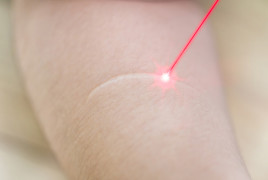Eczema types: Atopic dermatitis symptoms
Diagnosing atopic dermatitis
Learn how visiting a dermatologist can help diagnosis atopic dermatitis.
What are the signs and symptoms of atopic dermatitis?
Atopic dermatitis (AD) is often called “the itch that rashes” because it begins with itchy skin. Scratching the itchy skin causes a rash to appear.
This rash also tends to be very itchy.
AD causes itchy skin
No matter your age or where the AD appears on your skin, AD tends to itch.

AD can develop on any area of your skin at any age. However, at certain ages, it’s more likely to appear on certain areas of your body and have a unique appearance.
Here’s what’s most common during each stage of life.
Infants
Baby with AD
Rubbing the itchy skin causes a rash to appear. In babies, the rash often develops on the cheeks. The rash often feels dry, raw, and scaly.

Forms on the scalp and face, especially on the cheeks
Makes the skin dry, scaly, and itchy
Bubbles up, and then oozes and weeps fluid
Causes itching that may come and go
While babies often get AD on their head, it can appear on other areas of the body. Babies rarely develop AD in the diaper area. The skin stays too moist for AD. A rash in the diaper area is most likely diaper rash.
Because AD is so itchy, you may see an infant rub against bedding, carpeting, and other objects in order to scratch the itch. A baby may also:
Have trouble sleeping
Develop skin infections, commonly due to the rubbing
Act fussy, as AD causes discomfort
Children
Common places
This 6-year-old boy has atopic dermatitis in the creases of his elbows and on his feet — common places for AD to appear in children.

When AD begins between 2 years of age and puberty, a child often has these signs and symptoms:
A rash that often begins in the creases of the elbows or knees. Other common places for the rash to appear are the neck, wrists, ankles, and/or crease between the buttocks and legs.
Itchy, scaly patches where the rash appeared.
In time, the skin with AD can:
Get bumpy, looking like permanent goose bumps
Lighten (or darken) where AD appears
Thicken, turning leathery to protect itself from frequent scratching
Develop knots (only on the thickened skin)
Itch all the time (only on the thickened skin)
Thickened skin
This 7-year-old girl says the thickened skin on the back of her knees is always dry and always itches.

Swollen, discolored skin
Where you see a rash, you’ll see slightly swollen and discolored skin. In people who have white skin, the swollen skin tends to look red. People who have darker skin see a less noticeable color change, which ranges from a subtle gray to violet-brown. Regardless of skin color, the skin with a rash feels warmer than the surrounding skin.

Scaly, crusty patches
Sometimes a child develops a rash that causes patches of slightly raised, dry, and scaly AD.

Itchy spots
More common in children who have skin of color, an AD rash can cause small, itchy spots on the skin. Scratching can cause the spots to leak fluid and then crust over. People who have white skin tend to see reddish spots. If you have darker skin, the spots tend to look gray to violet-brown in color.

Adults
Patchy, scaly skin
Adults who have AD often have darker patches and scaly skin, as does this 30-year-old woman.

About 2% to 3% of adults have AD. Some developed AD as a child and continue to have AD. It’s also possible for AD to clear and return years later. While rare, AD can begin after 18 years of age.
In adults, AD tends to cause fewer rashes. Adults tend to have:
Extremely dry skin
Skin that is easily irritated
Hand eczema
Eye problems (eczema on eyelids, cataracts)
If you’ve had AD for years, patches of your skin may have permanently thickened and developed a leathery texture. This is caused by years of scratching. The affected skin also tends to look darker (or lighter) than the surrounding skin. The thickened skin can itch all the time.
Adults, unlike children, often have AD around their eyes. You’ll often see thickened, darker skin circling the eyes. This skin with AD tends to feel very itchy.
Itchy skin
Years of scratching caused permanently thickened skin on this woman’s hand and wrist. This skin always itches.

Signs and symptoms of AD that can develop at any age
Raw, bleeding skin or oozing
Scratching can lead to raw, irritated skin that bleeds. Sometimes, the skin opens and leaks fluids.

Deep lines in the palms
Some people who have AD develop deep, numerous lines in their palms. On light-colored skin, these lines may be slightly red as shown in this picture.

Skin infections
People with AD have a higher risk of developing a skin infection. Signs of a skin infection include yellow crusts and small, pus-filled bumps, as shown here.

Feelings of anxiety, depression, and isolation
Studies indicate that AD can cause feelings of anxiety and depression The findings from these studies indicate the depression and anxiety are often due to the itch, painful skin, and problems sleeping. People living with AD also say that they feel self-conscious and sometimes ashamed when other people can see the AD. This, too, may lead to feelings of depression and anxiety, which can cause people to spend more time alone.

Some people have a higher risk of developing AD. Do you have a higher risk? Find out at: Atopic dermatitis: Causes
Images Images 1 and 13: Getty Images Images 2, 5, 6, 7: Used with permission of DermNet NZ. Images 3,4,8, and 9: Images used with permission of the American Academy of Dermatology National Library of Dermatologic Teaching Slides.
References
Eichenfield LF, Tom WL, et al. “Guidelines of care for the management of atopic dermatitis Section 1. Diagnosis and assessment of atopic dermatitis.” J Am Acad Dermatol. 2014;70:338-51. McAleer MA, O’Regan GM, et al. “Atopic dermatitis.” In: Bolognia JL, et al. Dermatology. (fourth edition). Elsevier, China, 2018: 208:27.
 Think sun protection during Skin Cancer Awareness Month
Think sun protection during Skin Cancer Awareness Month
 How to care for your skin if you have lupus
How to care for your skin if you have lupus
 Practice Safe Sun
Practice Safe Sun
 Sunscreen FAQs
Sunscreen FAQs
 Fade dark spots
Fade dark spots
 Hidradenitis suppurativa
Hidradenitis suppurativa
 Laser hair removal
Laser hair removal
 Scar treatment
Scar treatment
 Botox
Botox
 Kids' camp - Camp Discovery
Kids' camp - Camp Discovery
 Dermatologist-approved lesson plans, activities you can use
Dermatologist-approved lesson plans, activities you can use
 Find a Dermatologist
Find a Dermatologist
 Why choose a board-certified dermatologist?
Why choose a board-certified dermatologist?